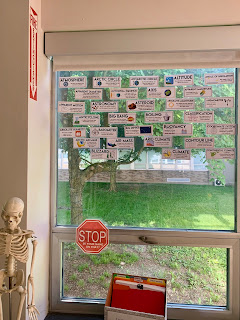3c: Engaging Students in Learning in outdoor labs
(Originally posted 9/13/09 on my previous classroom blog)
This week we went outside into the area where the homecoming bonfire is usually held. This is an area of annual renewal.

The plants present there today will be buried by a large pile of wooden pallets and will be burnt to the ground. The area will then begin to reestablish themselves and their population. So we spent one class period identifying the plants present and counting the number of individuals in that population. We studied many areas the size of a hula hoop. We did find some new species that we have not seen before and a very large spider which we are trying to identify. It was really nice to get out of the classroom and spend time studying our surrounding that we frequently overlook and ignore.
Later in the year we will refer back to the bonfire pit area because it shows ecological succession because the environment is going to start over again with bare soil, then weeds and small plants, eventually if it was left alone we would see small shrubs, small trees and eventually large trees and a climax forest. However our area will never get past the small plants stage because we have the Homecoming bonfire there every school year.
In this picture is a spider that was found in the bonfire pit area.
posted on ballinwithballing.blogspot.com
This week we went outside into the area where the homecoming bonfire is usually held. This is an area of annual renewal.

The plants present there today will be buried by a large pile of wooden pallets and will be burnt to the ground. The area will then begin to reestablish themselves and their population. So we spent one class period identifying the plants present and counting the number of individuals in that population. We studied many areas the size of a hula hoop. We did find some new species that we have not seen before and a very large spider which we are trying to identify. It was really nice to get out of the classroom and spend time studying our surrounding that we frequently overlook and ignore.
Later in the year we will refer back to the bonfire pit area because it shows ecological succession because the environment is going to start over again with bare soil, then weeds and small plants, eventually if it was left alone we would see small shrubs, small trees and eventually large trees and a climax forest. However our area will never get past the small plants stage because we have the Homecoming bonfire there every school year.
In this picture is a spider that was found in the bonfire pit area.
 |
| orb weaver spider |
posted on ballinwithballing.blogspot.com



Comments
Post a Comment